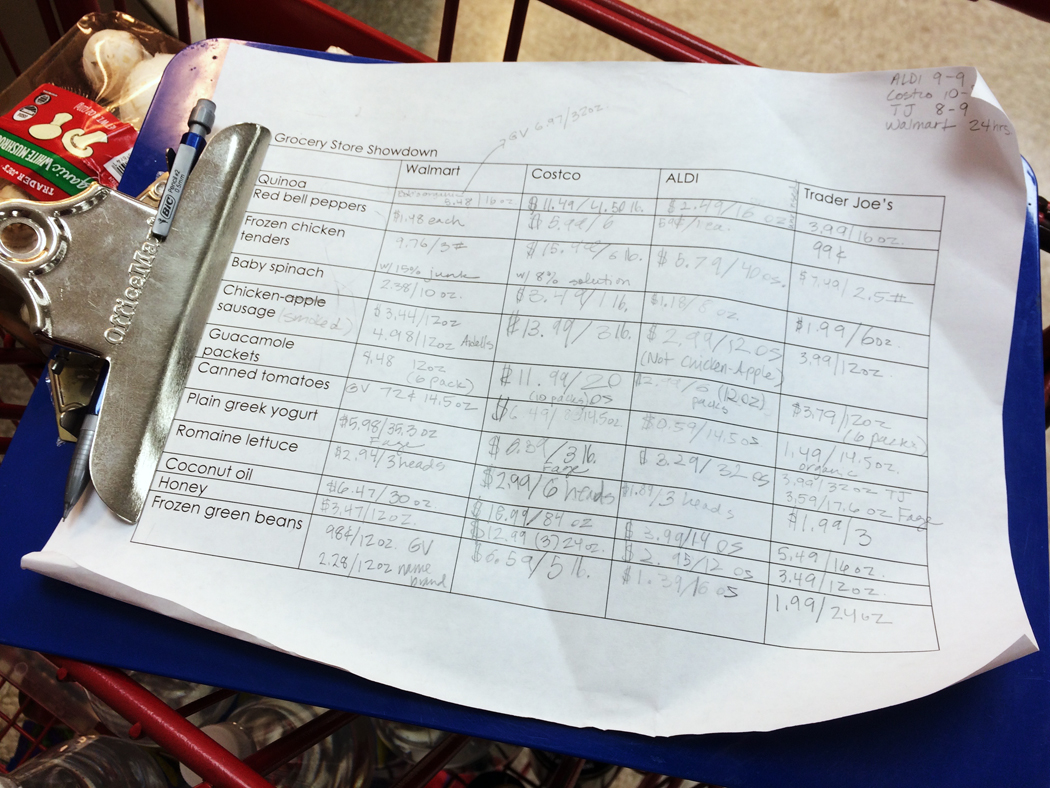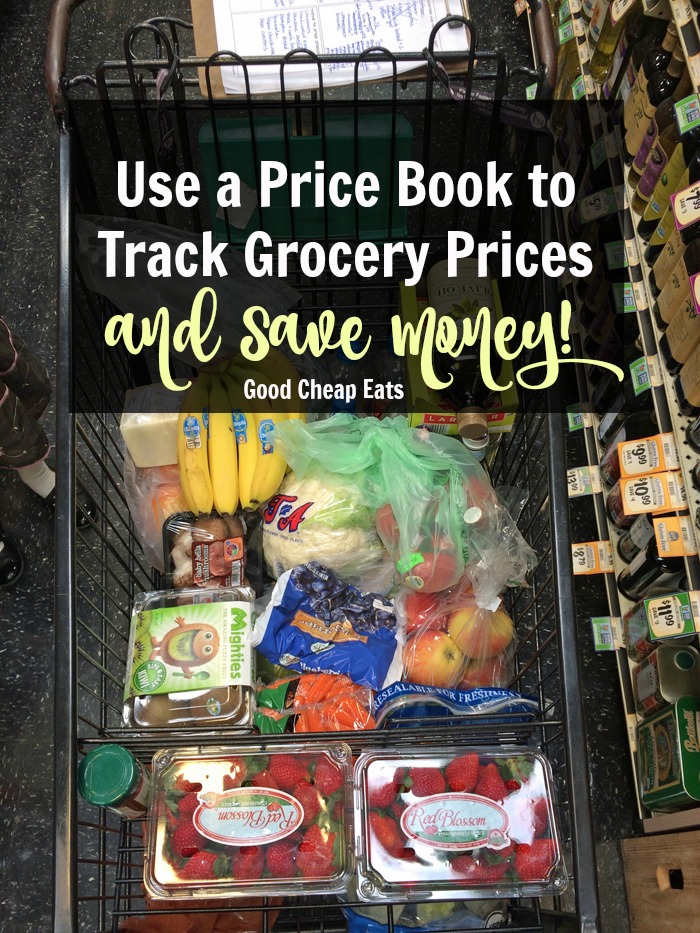Wondering if it makes a difference where you shop? It does! Use a price book to track grocery prices, shop the best deals, and save money.
Want to save this post?
Enter your email below and get it sent straight to your inbox. Plus, I'll send you budget recipes and money-saving tips every week!
I’ve never been one to keep a price book. I mean, I heard about them TWENTY YEARS ago, when I first picked up a copy of Miserly Moms at my grocery store. I was pregnant with my first child and we knew we were going to live on one income once the baby came. I devoured that book. In fact, it was my yearly read to keep me on the straight and narrow.
The author was somewhat of a math geek to me since she talked so much about unit costs in that first edition. I tried it a few times along the way, but felt content to just “keep it all in my head.” I had a basic idea of what different grocery items cost.
And for many years that system worked. Until it didn’t. Well, until I did an experiment.
I decided to get all mathematical. One weekend, my girls and I traveled to four different nation-wide grocery stores and wrote down the prices on 12 different healthy food items that we normally buy. Then we came home and did the math.
I was shocked and amazed at how the numbers crunched. My favorite store came in dead last, while two stores that take a bit of work to shop at were clearly the winners. I had no idea because I’d not made it a practice to track the unit costs.
Use a Price Book to Track Grocery Prices & Save Money
Since that a-ha moment, I’ve been keeping a price book in the form of a spreadsheet on Google Drive to help me track what we buy and how much each item costs at my different stores. I’ve crossed one of those nationwide chains completely off my list and am also tracking a California chain that I love — and hope it fares well! I like shopping there! LOL.
A price book is nothing more than a process of tracking prices so that you know a great deal when you see one. Not just what you think is a great deal.
Your price book can be as low-tech as a piece of paper and a pencil where you jot down prices. Or you can get a little more fancy with a spreadsheet. There are even several apps that will help you track grocery prices.
I decided to do my tracking in a Google Spreadsheet. I can access it from my desktop computer as well as from the Google Sheets app on my phone. That way, when I’m out grocery shopping, I can see at a glance what the lowest price is that I’ve paid in the recent past.
For instance, let’s look at the price of milk lately here in San Diego County:
- Ralphs – $2.99
- Costco – $2.25 (when you buy two)
- Trader Joe’s – $2.99
- ALDI – $2.40
- Sprouts – $3.29
Since we go through about 4 gallons a week, it’s not a problem for me to buy milk jugs “in pairs”. Since Costco is the cheapest place in town, that’s where we’re buying our milk, unless we’re pressed for time and already at one of the competitors.
I’ve been pretty lackadaisical about milk prices. I knew Costco was cheapest, but I hadn’t really thought about how it adds up. Let’s say that I was buying milk at one of the more expensive stores and paying 75 cents more per gallon. Doesn’t seem like a big deal, right? But, at four gallons a week, that’s a difference of $3 a week or $156 a year!
The price of milk does make a difference!
So, as I work to get our monthly grocery budget below the USDA’s predicted $1310 for our family, you can bet I’l be keeping a price book to track grocery prices and save money!
Do you keep a price book?
Not only does The Good Cheap Eats Club help you address the big question of where to grocery shop, it also tackles a myriad of challenges that cause you to struggle in the kitchen and getting food on the table. We walk through the Good Cheap Eats system that enables us to eat well, save money, and enjoy more free time.
Don’t be stuck without these strategies to save money while eating great food that you prepared yourself! Through live videos, done-for-you meal plans, recipe helps, and time-tested strategies for saving money, you’ll learn how to make planning, shopping, and cooking easier!
Get the support you need to make changes for the better!
The course includes:
- Encouragement and support to meet your goals
- Easy, doable strategies to eat better and save money
- Video courses to help you learn more
- Done-for-you meal plans that you can customize with our digital meal planning platform
- Grocery budgeting helps, including free resources each month
- Ideas and worksheets for reducing spending, choosing the best grocery store, meal planning, using up leftovers, packing better lunches, making healthy food swaps, making better meals, preparing food to freeze, and more.
Join the club now and start saving more.






Michelle
I have been interested in using a price book for a couple of years but one thing or another needed more of my time and attention.
I have a few questions:
1) do you print a new sheet each shopping trip or do you use the previous one as a guide then update the prices to reflect a sale or change (supply/demand; market fluctuation)?
2) do you note the date on your sheet (or with the items) so you know when the price change occurred or when you last purchased that item?
3) do you track all grocery/pantry/household expenses or only the ones you buy most often?
I do not want to make this more complicated (I promise!) but I do not want to miss helpful information right from the start. =)
Thanks for this post. I refer to it several times a year to remind myself I need to keep an eye on expenses and to keep thinking through how this would work best for my family.
Stewart Hart
And what might the several apps that will help you track grocery prices?
Jessica Fisher
Go to the app store and search: price book. I found several that way. A google search will show you more. Since I maintain mine in a spreadsheet, I don’t personally use an app, so I don’t have a specific one to recommend.
Miriam
my spread sheets are hard to navigate on the phone, how do you manage that?
Jessica Fisher
I prefer to use apps that are made for the phone. I keep a lot of records in the preinstalled Reminders and Notes apps for ios.
Janet
I spend about 90% of my grocery shopping dollars at one store. I keep a price book. In my case I use the price book to track the sale cycles so I know when to stock up when a good price rolls around. I spend the other 10% on produce at a second store during the winter and at the farmers market in the warm weather. I think every family has to balance price and quality. We all love beef, but we do not purchase steaks more than 2 or 3 times a year. If we are going to eat a steak we want it to be good quality beef.
Jessica Fisher
Great strategies!
Laura
Thank you for sharing, this is a great idea for me to use with where I live and the limited stores available nearby (“nearby” being a relative term).
To all the tired mamas with little ones: if you feel like your brain is not working properly to pull off a price list project… do the best you can in the time that you have, then feel good about doing a small thing that may have a big impact (like the example in this article of just looking at milk prices).
Rebecca
Hi.
We’re ovo-lacto vegetarians. Is your E-Course for me? By the way. we have your good, cheap eats book. I love your vegetarian recipes in it!
Jessica Fisher
Hi Rebecca! So glad you enjoy the cookbook. Yes, the course is for YOU! You can ignore the one cooking tutorial that isn’t plant-based. I think everything can be applied/easily-adapted.
Laurie in CA
I’ve never kept a price list. I don’t strictly go by cost in purchasing my food. Taste, texture and quality really factor in. Example, I’ve tried many plain greek yogurts. I like Trader Joe’s the best for taste and texture, has great ingredients and TJ is the closest grocery store to my house. I also think their price is pretty good but I haven’t done a price comparison. Even if I did it, wouldn’t change what I purchase. I have a problem with acid in coffee so I purchase Peet’s Alma de la Tierra at Costco. Peet’s cost more, but it is worth it to me. I basically shop at four stores all within 12 minutes of my house. We don’t have many chains that the rest of the country does (no Aldi’s, Kroger, Publix, Ralph’s). I’m not a food snob but I do like quality food.
Jessica Fisher
I agree that there are other reasons for making a purchase besides price. However, if all things were equal (or better) then I think it pays to know the unit prices. For instance, I’ve been buying the XL avocados from Sprouts because they were the best quality I could find. Standard price is $1.66, but I’ve paid as high as $2.50, depending on the situation. I found recently that Costco sells the XL for $1.20 and they were WONDERFUL. Win-win.
I think with all things, “your mileage may vary”, but I’m finding that the price does make a difference. And…. my husband drives by the far stores every day on his way home from work. LOL!